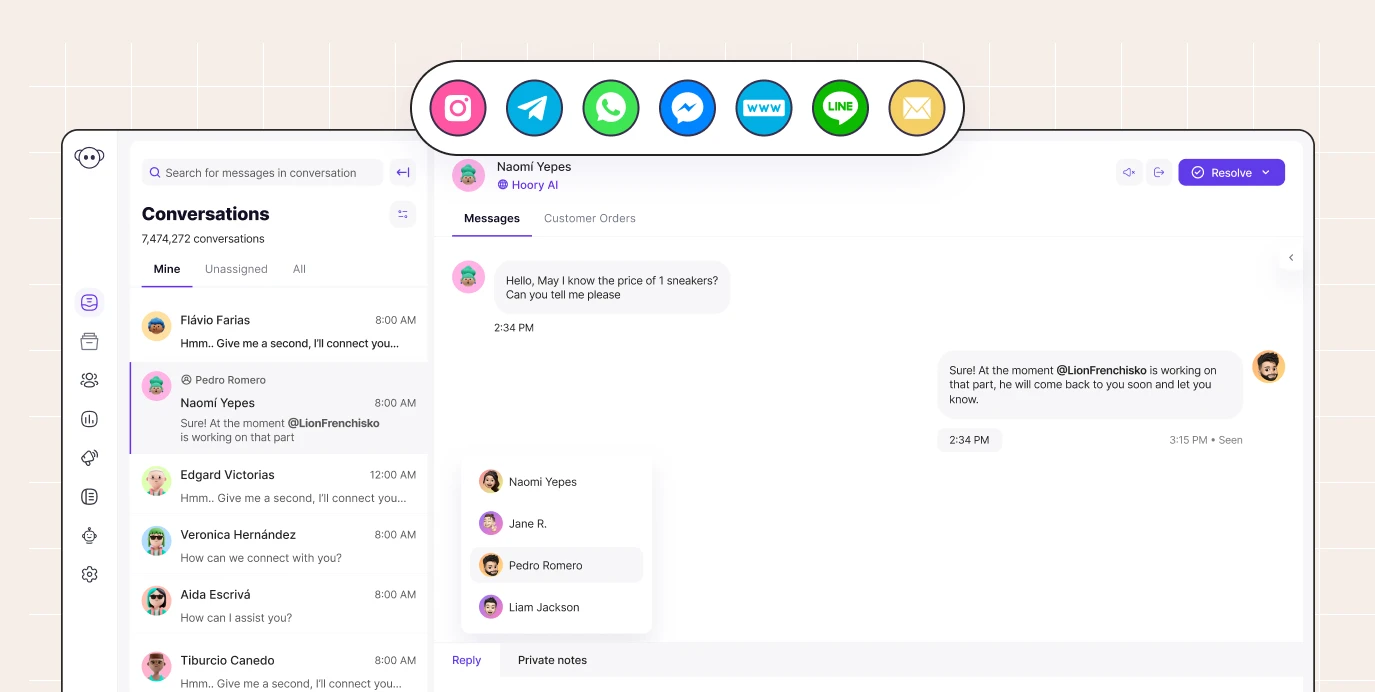Omnichannel Customer Experience: An In-Depth Guide
• Customer Support
• FastBank

In the fast-paced landscape of modern business, mastering the art of omnichannel customer experience is non-negotiable.
To stay ahead in the competitive arena, you must understand and implement the principles of omnichannel inbox, ensuring your business meets and exceeds the expectations of the modern, interconnected consumer.
Read this in-depth guide to unpack the pivotal concepts of omnichannel journeys and customer experience, offering a concise roadmap for businesses seeking to elevate their customer interactions across all touchpoints.
What is Omnichannel Customer Experience?
Omnichannel customer experience represents a comprehensive approach to customer interactions, seamlessly integrating various channels and touchpoints to provide a unified and cohesive experience.
In today's dynamic business landscape, characterized by the rapid increase in digital platforms, social media, and mobile devices, customers expect a seamless transition between online and offline channels. This strategy ensures that customers can effortlessly move across channels—websites, mobile apps, and social media—while enjoying a consistent and personalized experience.
The importance of omnichannel customer experience lies in its ability to cater to modern consumers' evolving needs and preferences.
Moreover, a well-executed omnichannel strategy can increase operational efficiency and cost savings by streamlining processes and improving organizational communication.
In essence, omnichannel customer experience solutions reflect a customer-centric mindset, acknowledging that consumers are no longer confined to a single channel for engagement.
Benefits of Omnichannel Customer Experience
More Choice for Customers
One of the paramount advantages of omnichannel customer experience is the empowerment it provides to customers through an expanded array of choices. By seamlessly integrating various channels, businesses offer consumers the flexibility to engage and transact across a spectrum of platforms—online, in-store, mobile apps, or social media.
This multichannel accessibility accommodates diverse customer preferences and provides a more personalized and tailored shopping journey. Customers can choose the channel that best suits their needs at any given moment, fostering a sense of control over their interactions with the brand.
This freedom of choice enhances customer satisfaction and increases loyalty, as customers appreciate the convenience and flexibility businesses offer.
Improved Customer Retention and Revenue
The convenience and fluidity offered by omnichannel customer experience solutions often translate into higher customer satisfaction, a key driver for retention.
The positive impact on customer retention, in turn, contributes significantly to revenue growth. Loyal customers are more likely to make repeat purchases, engage in upsells, and become brand advocates, amplifying a company's overall sales potential.
Ultimately, as businesses embrace omnichannel strategies, they find themselves not only retaining existing customers but also unlocking new revenue streams through the strengthened loyalty of their customer base.
Cater to a Broader Audience
The omnichannel customer experience solutions offer a distinct advantage by enabling businesses to cater to a broader and more diverse audience.
This approach ensures a brand's reach extends beyond a singular demographic or channel-specific audience. The omnichannel strategy accommodates diverse consumer behaviors, whether a customer prefers shopping on a website, using a mobile app, or engaging in person at a brick-and-mortar store.
By breaking down the barriers between different touchpoints, businesses can connect with individuals having different comfort levels or preferences regarding their shopping experience. This inclusivity broadens the audience and enhances the brand's accessibility, making it more appealing to a spectrum of consumers.
Collect Better Data
Implementing an omnichannel customer experience strategy provides a distinct advantage in collecting richer and more insightful data. This multifaceted approach enables the collection of diverse data sets, including customer preferences, behaviors, and feedback across different channels.
The synergy of data from these channels offers a comprehensive understanding of the customer journey, allowing businesses to identify patterns, predict trends, and personalize offerings.
The depth and breadth of data obtained through omnichannel experiences empower organizations to refine their marketing strategies, optimize product offerings, and tailor customer interactions.
Omnichannel vs Multichannel Customer Experience
Multichannel and omnichannel approaches involve interacting with customers through various platforms, such as online, in-store, and mobile. However, the critical difference lies in the level of integration and cohesion between these channels.
Multichannel setups operate in chambers, each channel functioning independently, offering separate experiences.
On the other hand, omnichannel journeys and customer experience are characterized by a seamless integration of all channels, providing customers with a unified and consistent journey across touchpoints.
Multichannel strategies may offer convenience through various channels but risk fragmenting the customer experience. In contrast, omnichannel strategies prioritize a unified customer journey, allowing individuals to transition effortlessly between channels without losing continuity.
The advantage of omnichannel is its ability to create a synchronized and personalized experience, where customer data is shared across channels, enabling businesses to comprehensively understand customer behaviors and preferences.
4 Steps to a Successful Omnichannel Transformation
Customer Journey Mapping
Begin your omnichannel transformation by mapping the entire customer journey across all touchpoints. Understand how customers interact with your brand online, in-store, through mobile apps, and other channels. Identify critical touchpoints, pain points, and opportunities for seamless integration. This mapping is the foundation for crafting a cohesive and interconnected customer experience.
Data Integration & Centralization
Establish a robust data infrastructure that integrates customer data from various channels into a centralized system. This unified data repository ensures a 360-degree view of customer interactions, enabling personalized experiences. Invest in technologies facilitating real-time data sharing among departments to create a synchronized and consistent customer experience across all channels.
Channel Selection
Choose a strategic channel mix to create a seamless and integrated customer journey. This includes not only traditional retail channels but also emerging digital platforms like a live chat widget, enabling instant customer communication. The goal is to offer a consistent and interconnected experience across every chosen channel, ensuring customers can transition effortlessly between them without sacrificing continuity.
Cross-Channel Consistency
Ensure a consistent brand message and user experience across all channels. From marketing campaigns to customer service interactions, maintain a unified voice and design aesthetic. This consistency fosters customer recognition and trust. Implement technologies that enable customers to seamlessly transition between channels without losing context, creating a fluid and continuous experience.
How to Improve The Omnichannel Customer Experience
Analyze Content For Enhanced Customer Experience
Analyzing your marketing content is crucial to understanding its impact on the customer journey. Identify where various content types (informative, educational, engaging) appear. During the analysis, prioritize correct and updated informational content, such as business contact details. Ensure the functionality of phone numbers, web links, and chatbots to maintain high-quality customer service and a seamless transition across marketing channels.
Invest In Digital Growth
Expand your digital presence by utilizing multiple platforms and enhance it with an omnichannel marketing strategy. Consistent messaging across all digital platforms strengthens brand awareness and provides a uniform customer experience. Whether customers engage with your brick-and-mortar store or visit your business website, they encounter the same brand identity and messaging, fostering a cohesive journey.
Optimize Integrated Content
Optimize campaign-specific content for potential use in omnichannel marketing. Use similar imagery and messaging across digital platforms to create a cohesive customer journey. Maintain clarity in campaign information, especially in discounted promotions through PPC ads, by transparently communicating terms and conditions. Consistent reference to terms and conditions throughout the campaign ensures that customers are well-informed, significantly improving the overall customer journey.
FAQ About Omnichannel for Customer Experience
How Does Digital Technology Improve Customer Service?
Digital technology revolutionizes customer service by delivering real-time support, personalized interactions, and streamlined processes. Automation accelerates query resolution, and AI-powered chatbots deliver instant assistance. Online platforms and social media provide seamless communication and rapid feedback channels. This technological synergy enhances efficiency, responsiveness, and overall customer satisfaction, cultivating a dynamic and customer-centric service environment.
What Defines a Good Omnichannel Customer Experience?
Excellent omnichannel journeys and customer experience are defined by seamless integration across all touchpoints. Regardless of the channel, it requires consistency in messaging, user experience, and service quality.
It is like an orchestra of multiple sections. Each of them can play and sound beautiful separately. But the piece can easily become a royal mess if they are not in sync with each other.

























